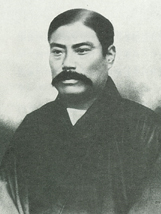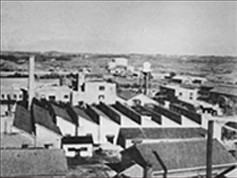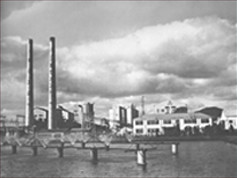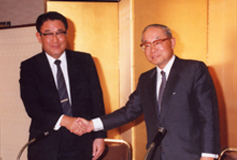Corporate History
The original starting point for the company known today as Mitsubishi Materials was as the mining business of Tsukumo Shokai, the roots of the Mitsubishi Group. For nearly 150 years, the company has grown, developing its activities along with the modernization of Japan. Mitsubishi Materials joins the companies of the Mitsubishi Group in striving to contribute to the creation of a comfortable global community in the 21st century.
In Step with Modern Japan
 Founder Yataro Iwasaki
Founder Yataro Iwasaki
(photos by the Mitsubishi Archives)
The corporate history of the Mitsubishi Group mirrors the modernization of Japan that began with the Meiji Restoration in 1868. The man who laid the cornerstone of the Group in this era was founder Yataro Iwasaki. It was Yataro who, in 1870, established Tsukumo Shokai, a shipping company, and aggressively invested in coal and mineral mining, which grew into a key pillar of operations for Mitsubishi.
| 1871 | Tsukumo Shokai, precursor to Mitsubishi Shokai, leases a coal mine from the Shingu clan in Kishu, and enters the mining business. |
|---|---|
| 1873 | Mitsubishi Shokai, precursor to Mitsubishi Goshi Kaisha, acquires the Yoshioka Mine in Okayama Prefecture, and enters the precious metals mining business. |
| 1893 | Mitsubishi Goshi Kaisha is established. |
| 1896 | Buys a refinery in Osaka from the goverment and enters the metal refining business. |
| 1917 | Establishes the Mining Research Institute, now the Central Research Institute.
Establishes the Naoshima Smelter & Refinery. |
Decentralized, Diversified Businesses Get New Start in Postwar Japan
 Niigata Metals Plant (now Diamet Corp.)
Niigata Metals Plant (now Diamet Corp.)
In the 1920s, the divisions of the Mitsubishi Goshi Kaisha split off into companies. Mitsubishi Mining Company Ltd., was established and assumed the assets of mining-related divisions. The energetic development of Mitsubishi Mining laid the foundation that supports the technical capabilities of today's Mitsubishi Materials. After World War II, the company was split into two mining interests, one for coal and the other for metals, in accordance with a law to eliminate excessive concentrations of economic power held by some corporate groups.
| 1918 | Mitsubishi Mining Company Ltd., established and takes over the coal and metal mining operations of the Mitsubishi Goshi Kaisha as well as operation of the research facility. |
|---|---|
| 1920 | Kanda Plant (now, Kyushu Plant) established by Hokoku Cement Corp. |
| 1921 | Mitsubishi Mining Company Ltd., lists on the Tokyo Stock Exchange. |
| 1942 | Tokyo Metals Plant (now, Tsukuba Plant) made into independent operation and begins full-scale production of cutting tools. |
| 1944 | Niigata Metals Plant (now, Diamet Corp.) established to manufacture sintered products. |
| 1950 | Breakup of coal (Mitsubishi Mining Co., Ltd.) and metal (Taihei Mining Co., Ltd.) divisions due to law regarding decentralization. |
Rebuilding along with Society after the War
 Mitsubishi Cement Kurosaki Plant (1956)
Mitsubishi Cement Kurosaki Plant (1956)
Japan was the scene of unprecedented economic growth in the 1950s and the 1960s. In response to energy reforms, shifting demand from coal to petroleum and nuclear energy, the business activities of the independent coal and metal mining operations were reorganized. The new divisional makeup contributed to better lifestyles for the people of Japan.
| 1950 | Taihei Mining Co., Ltd. lists on the Tokyo Stock Exchange. |
|---|---|
| 1952 | Taihei Mining Co., Ltd. changes its name to Mitsubishi Metal Mining Company Ltd. |
| 1954 | Mitsubishi Cement Corp. is established and enters the cement business. |
| 1959 | Japan Electronic Metals Co., Ltd., is established and enters the field of high-purity silicon for semiconductors. |
| 1962 | Mitsubishi Reynolds Aluminum (now Mitsubishi Aluminum Co., Ltd.,) is established as a general manufacturer of rolled aluminum products. |
| 1971 | Mitsubishi Nuclear Fuel Co., Ltd., is established to manufacture nuclear fuels. |
| 1972 | Fujioyama Plant (now Fujioyama Plant of Universal Can Corp.) is established and enters the aluminum beverage can business. |
| 1973 | Mitsubishi Mining Co., Ltd., Mitsubishi Cement Corp., and Hokoku Cement Corp. merge into Mitsubishi Mining & Cement Co., Ltd.
Mitsubishi Metal Mining Co., Ltd. changes name to Mitsubishi Metal Corporation. |
| 1976 | Production and sales of ceramic electronic components begins. |
| 1988 | Mitsubishi Cement Corp. is established in the United States, marking entry into the overseas cement business. |
Into the Future as Mitsubishi Materials
 At Press Conference April 1990
Mitsubishi Metal President Takeshi Nagano(Left),Mitsubishi Mining & Cement President Masaya Fujimura(Right)
At Press Conference April 1990
Mitsubishi Metal President Takeshi Nagano(Left),Mitsubishi Mining & Cement President Masaya Fujimura(Right)
The 1990s was a time of considerable political, economic and social transformations around the world. This decade brought an end to the cold war, the development of a sophisticated information society, upheavals in world economy and greater internationalization.
Another major development was the 1990 merger of Mitsubishi Metal and Mitsubishi Mining & Cement into Mitsubishi Materials Corporation. This did not mark a simple return to the prewar Mitsubishi Mining. Both corporate entities had achieved great changes in the postwar years and, standing on equal footing, they joined forces in a much different format.
Mitsubishi Materials, which traced the same path of Japan in its pursuit of modernization, aims to contribute to a comfortable global society in the 21st century.
| 1990 | Mitsubishi Metal Corp. and Mitsubishi Mining & Cement Co., Ltd. merge to form Mitsubishi Materials Corporation on December 1. |
|---|---|
| 1991 | Merges with Tohoku Kaihatsu Co., Ltd., on October 1. |
| 1996 | Establishes PT. Smelting in Indonesia. |
| 1998 | Forms comprehensive business tieup with Ube Industries, Ltd. and establishes Ube-Mitsubishi Cement Corp. |
| 1999 | Commences the recycle business of home appliances waste. |
| 2000 | Strengthens tool business with acquisition of Shinko Kobelco Tool Co., Ltd. (now, Akashi Plant) |
| 2001 | Begins production of aluminum bottle cans at Okayama Plant. (now Okayama Plant of Universal Can Corp.) |
| 2002 | Integrates silicon wafer business with that of Sumitomo Metal Industries, Ltd. (now Nippon Steel Corp.) to create Sumitomo Mitsubishi Silicon Corp. (now SUMCO Corp.) |
| 2004 | Integrates copper tube business with that of Kobe Steel, Ltd. to create Kobelco & Materials Copper Tube, Ltd. |
| 2005 | Commences Universal Can Corporation by integrating aluminum beverage can business with Hokkai Can Co., Ltd. (now Hokkan Holdings Ltd.) |
| 2007 | Merger with Mitsubishi Materials Polycrystalline Silicon Co., Ltd. Yokkaichi plant was inaugurated.
Merger with Mitsubishi Materials Tools Co., Ltd. Akashi plant was inaugurated. |
| 2008 | Mitsubishi Shindoh Co., Ltd. became consolidated subsidiary company. |
| 2010 | Mitsubishi Cable Industries Co., Ltd. became consolidated subsidiary company. |
| 2012 | Robertson's Ready mix Ltd. became wholly owned subsidiary company of MCC Development Corp. |
| 2015 | Hitachi Tool Engineering, Ltd., became consolidated subsidiary and changed its name to Mitsubishi Hitachi Tool Engineering, Ltd. (now MOLDINO Tool Engineering, Ltd.) |
| 2017 | Acquired the Special Products Division of the Luvata Group, which specializes in the processed copper products. |
| 2019 | Transitioned to a company with three designated committees (nomination, audit, and remuneration committees). |
| 2020 | Merger with Mitsubishi Shindoh Co., Ltd. Wakamatsu Plant and Sambo Plant were inaugurated. Made Mitsubishi Hitachi Tool Engineering, Ltd. a wholly owned subsidiary and changed the name to MOLDINO Tool Engineering, Ltd. |
| 2021 | Mantoverde S.A. became an equity-method affiliate. |
| 2022 | All shares held in Universal Can Corporation were transferred. Through an absorption-type company split, the aluminum rolling and processing business of Mitsubishi Aluminum Co., Ltd. was transferred to Showa Aluminum Can Corp. (currently Altemira Co., Ltd.). Through an absorption-type split, the cement business and its related businesses were transferred to Mitsubishi UBE Cement Corporation. |
| 2023 | Absorbed Materials' Finance Co., Ltd. Onahama Smelting & Refining Co., Ltd. became a wholly owned subsidiary. Through an absorption-type company split, the polycrystalline silicon business was transferred to High-Purity Silicon Corporation, and all shares of that company were transferred. |
| 2024 | Appi Geothermal Energy Corporation became a consolidated subsidiary. Expanded and reorganized functions of MM Netherlands B.V. and established Mitsubishi Materials Europe B.V. Acquired all shares of H.C. Starck Holding GmbH through Mitsubishi Materials Europe B.V. |
Reference
For a closer look at the history of the Mitsubishi Group, go to the Mitsubishi Group portal site.
The portal site of the Mitsubishi companies “mitsubishi.com”